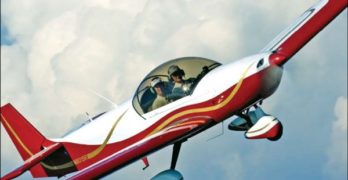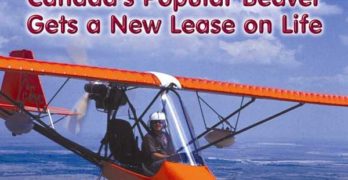When Air Création introduced their beautiful Tanarg trike to American pilots in 2005, it earned a very warm response and, at the same time, shock at its $53,000 price tag – some $10,000 more than the next closest high-end trike.
Pronounced Tan-ARG (rhyme it with “barge,” except the G is said softly, more like TAN-arz), the machine is impressive. Even for those pilots or newcomers who regard weight-shift control trikes as “weird,” or “hard to understand,” the Tanarg design concept earns respect rapidly. This aircraft has received enormous attention to detail while also gaining in strength and ease of use. Air Création engineers built on many successful years of designing and producing lots of trikes – some 2,500 of them – to create a stunning work of aeronautical art. Nothing on the market is quite like the Tanarg.
The last time I wrote about Air Création, I talked about my experience with their wonderful new iXess wing (once again introducing a hard-to-pronounce name).
Search Results for : MG 21
Not finding exactly what you expected? Try our advanced search option.
Select a manufacturer to go straight to all our content about that manufacturer.
Select an aircraft model to go straight to all our content about that model.
IndUS Sky Skooter…Proven Trainer with ePod
he proven airframe and modern panel of the Sky Skooter make perhaps the oddest, yet most appropriate of mates. Each from a different age – the T-211’s unique ribbed wing beckons from the 1940s while the ePod streaks ahead in the 2000s – they nonetheless complement each other.
The Sky Skooter is the fun little variant of the T-211 series, including the FAA-certified T-211 and the ASTM standards-compliant (LSA certified) Thorpedo. The company can deliver just about any version of John Thorp’s groundbreaking design, the very one that lead to Piper’s Cherokee, which sold tens of thousands.
Complementing the joyful and innocent Sky Skooter with the most pleasant in-flight handling comes the visitor from the future: IndUS Aviation’s ePod. Putting these together for a flight review shows the past and the future of light-sport aviation.
Long Perspective
The T-211 has a long, rich aviation history. The model dates back to designs studies in the early 1940s that lead to the Lockheed Little Dipper, a single-place light aircraft created by legendary designer John Thorp.
GT Ultralights: A Versatile Trike Supplier
Ukrainian airframe producer Aeros has risen from complete obscurity in the early 1990s (after the Berlin Wall fell) to wide recognition in recreational aviation. Although powered ultralight and light-sport aircraft enthusiasts may not immediately know the brand, hang glider pilots around the world are very aware of the name. The current reigning world champion hang glider pilot is Oleg Bondarchuck, a Ukrainian pilot who works with Aeros.
This young company emerging from the former Soviet mantel also makes an ultralight sailplane plus two powered aircraft. Aeros produces the Sky Ranger 3-axis airplane (under agreement with its French designer), and it has designed and markets its own trike. The company also supplies trike wings for other producers like Antares. By any normal measurements, Aeros is a versatile company.
Many ultralight and LSA pilots probably know the Aeros Velocity trike, and may recall its earlier name, Venture. In those days, it was sold by Sabre Aircraft alongside the trikes that Arizona company made here in America.
Have it your way…CH-601 XL or XLi
The strongest interest in readyto-
fly special light-sport aircraft
(S-LSA) to date has come
from pilots operating Cessna, Piper,
Mooney, and other general aviation
(GA) aircraft. It is estimated that more
than 100,000 currently certificated pilots
are looking at their prospects for
maintaining an up-to-date second- or
third-class FAA medical and considering
the LSA option. Many are concluding
that LSA are worthy airplanes
and recognize that downsizing to an
LSA two-seater can meet their flying
goals, a fact that has driven a good
share of LSA sales thus far.
Thousands of those pilots have private
or higher certificates with instrument
ratings. They’re accustomed to
having a full panel and want one even
if flying in instrument meteorological
conditions (IMC) isn’t in their plans. In
fact, flashy dual-screen plus electronic
information and navigation panel
layouts have proven quite popular in
many S-LSA, even though they add tens
of thousands of dollars in cost.
Float-Flying the M-Squared Sprint 1000
“Air in your hair!
Space on your face! A breeze on your knees!” A former colleague of mine used to repeat this short mantra to illustrate the joy of open-cockpit flying. It was catchy and engaging and his customers liked it.
With 15 Light-Sport Aircraft now possessing their FAA Special Light-Sport Aircraft (SLSA) airworthiness certificates, not a single one is open cockpit, though the IndUS Thorpedo, Legend Cub, and Tecnam Sierra can enjoy partially open cockpits.
Special Light-Sport Aircraft will eventually add more of this genre of light aircraft but one of the beauties of FAA’s new regulation is that it does not eliminate two previous categories: Amateur-built 51% kits or Part 103-compliant ultralights.
With 21¼4 years left before operators of 2-seat 496-pound empty weight ultralight exempt trainers must register in FAA’s new Light-Sport Aircraft category, and with 41¼4 years left while these machines can be used for compensated training flights, the segment still has lots of life remaining.
LSA Market Shares Based on FAA Registry
Lots of people want to know…customers, insurance companies, dealers, membership organizations, and, of course, all the manufacturers and importers. We all like to keep score. While I believe FAA data has some delay in reporting, it is a reputable source of info. Here’s what their registrations show through the end of March, 2007. *** Flight Design remains #1 at 21% — #2 American Legend remains the largest U.S. producer with 13% of all registrations. These two are followed by #3 Evektor at 8% — #4 TL Ultralights (StingSport) at 7% — #5 Tecnam at 6% — #6 Fantasy Air at 6% — #7 AMD (CH-601) at 5% — #8 LSA America (Skyboy) at 4% — #9 CubCrafters at 4% — and #10 Jabiru at 3% of all SLSA registrations. These aircraft account for 552 aircraft or 77% of 719 registered SLSA airplanes.
Just Aircraft’s Highlander
If you’re familiar with Avid Flyer or Kitfox aircraft, you know at least something about Just Aircraft’s Highlander. Its pedigree “path” is somewhat meandering but leads to an excellent flying machine born of a rich American airplane design heritage.
Dean Wilson was the originator of this now-proven design shape. The first departure from Wilson’s Avid Aircraft company was Dan Denney, who went on to offer the Kitfox. Denney’s prowess as a marketer brought international fame to the Kitfox and, over the years, the sale of nearly 3,000 aircraft. At one time Denney Aerocraft was among the country’s largest suppliers of kit-built aircraft. What had been an ultralight design evolved into a successful 2-seat homebuilt, but that wasn’t the end of the evolution behind Wilson’s original creation. Denney sold his company to Phil Reid, who renamed the Idaho company SkyStar.
A Well-Evolved History
Another break-off from Avid Aircraft and Denney Aerocraft was Flying K Enterprises, which introduced the single-seat Sky Raider.
Boathull Corsario Arrives in America
Brazilian Amphibious Beauty
Most Americans
are unaware of the Corsario. Importer Steven Cohen is out to change that. He and his partner, Phil Klein, are marketing this handsome amphibian, which they import from Brazil. Not a brand-new design, this is the MK5 model – it’s been through four previous iterations.
The Corsario comes from a South American company called Microleve founded in 1982, back near the beginning of the ultralight era. The company proudly states, “Aside from being the first ultralight manufacturer in Brazil, the quality of our products has made Microleve the biggest seller of ultralight aircraft in Latin America.”
In 23 years of operation, Microleve claims to have delivered more than 1,400 ultralight aircraft, including almost 20 different models, named as MX1, MX2, ML200, ML300, ML300M, ML300MF, ML400, ML400T, ML450, ML500T, CORSARIO MK1, MK2, MK3, MK4, and MK5. As you might surmise by reviewing this list, the Brazilian company has taken several of their models through a series of refinements and the Corsario is no exception.
Beaver RX-550
Perhaps the most famous ultralight to come out of Canada is the Beaver. With a reported 2,200 units flying since the early 1980s, this is one of the most successful light aircraft ever. However, due to missteps by companies that previously manufactured the brand, this popular ultralight was nearly lost from the ultralight aviation landscape. Were it not for the Aircraft Sales and Parts (ASAP) company and the Holomis family, you might not have this choice today.
Originally the Beaver RX-550 came from a company called Spectrum Aircraft. A company reorganization left the ultralight in the hands of a company named Beaver RX Enterprises. Both these business names disappeared and today the ASAP brand carries the Beaver into the sky.
In 1993, a couple years after our last report on the Beaver1, the old company closed its doors and effectively stranded thousands of Beaver ultralight owners and all the dealerships that sold them.
Sky Skooter Makes Two SLSA for IndUS
Dallas, Texas-based IndUS Aviation earned their second SLSA model approval with certification of the T-11 Sky Skooter. Powered by the four cylinder, 85-hp Jabiru 2200, Sky Skooter becomes the lighter sibling to the potent Thorpedo, which uses the 120-hp Jabiru 3300 on the same airframe. Compared to IndUS’s T-211 with the Continental O-200 engine, the smaller Jabiru saves 100 pounds. Fuel burn is stated as 4 gph at economy cruise. At the design’s birth in 1944, Sky Skooter was designed around a 50-hp Franklin engine. With the lighter engine, the 2006 Sky Skooter tips the scales at a modest “645 pounds empty,” commented Ram Pattisapu, owner of IndUS. That is less than most Light-Sport Aircraft and brings pleasant handling as I found in a short flight in the prototype Sky Skooter. I find it refreshing to see a company use a smaller powerplant and simpler aircraft. But I ask the same question as with the Skykits Savannah ADV: Is Sky Skooter a “new” model for our SLSA List?
- « Previous Page
- 1
- …
- 82
- 83
- 84
- 85
- 86
- …
- 94
- Next Page »











